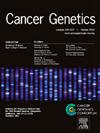ADAR1 gene expression and its importance in breast cancer
IF 2.1
4区 医学
Q4 GENETICS & HEREDITY
引用次数: 0
Abstract
RNA editing mediated by ADAR1 is vital for the survival of mammals, and its malfunction leads to irregular editing of its targets, potentially influencing the observable characteristics of breast cancer. The study aims to investigate ADAR1- p110 and ADAR1-p150 gene expression in breast cancer patients' tissue samples (tumor and normal), to determine the role of this expression in tumor development, and to correlate expression levels with patients' clinical findings to understand breast cancer heterogeneity. In this research, we used tumor and adjacent normal tissue samples from 75 patients diagnosed with breast cancer who had undergone surgery. The levels of gene expression were determined using reverse transcription-quantitative polymerase chain reaction (RT-qPCR). The study found that ADAR1-p110 expression was significantly higher (1.32-fold, p < 0.0001) in tumor tissue compared to adjacent normal tissue. Similarly, ADAR1-p150 expression also showed a significant increase (1.58-fold, p < 0.0001) in tumor tissue compared to normal tissue. ADAR1-p150 expression was significantly higher in ER (estrogen receptors )-positive patients compared to ER-negative patients (p = 0.04). Additionally, patients with lobular histology showed significantly higher ADAR1-p150 expression levels compared to those with ductal histology (p = 0.02). Our findings, obtained by using tumor and normal tissue from the same individual, demonstrate increased ADAR1 gene expression in tumor tissue. Considering the literature data indicating ADAR1′s association with drug resistance and the correlation we observed between ADAR1 expression levels and certain clinicopathological data of the patients, it is evident that ADAR1 expression is a parameter that should be taken into account in treatment planning.
ADAR1基因表达及其在乳腺癌中的意义
ADAR1介导的RNA编辑对哺乳动物的生存至关重要,其功能障碍导致其靶标的不规则编辑,可能影响乳腺癌的可观察特征。本研究旨在研究ADAR1- p110和ADAR1-p150基因在乳腺癌患者组织样本(肿瘤和正常)中的表达,确定其在肿瘤发展中的作用,并将表达水平与患者临床表现相关联,以了解乳腺癌的异质性。在这项研究中,我们使用了75名接受过手术的乳腺癌患者的肿瘤和邻近正常组织样本。采用逆转录-定量聚合酶链反应(RT-qPCR)测定基因表达水平。研究发现,ADAR1-p110表达显著增高(1.32倍,p <;0.0001),肿瘤组织与邻近正常组织相比。同样,ADAR1-p150的表达也显著增加(1.58倍,p <;0.0001),与正常组织相比。雌激素受体(ER)阳性患者ADAR1-p150表达明显高于ER阴性患者(p = 0.04)。此外,小叶组织学患者的ADAR1-p150表达水平明显高于导管组织学患者(p = 0.02)。我们通过使用来自同一个体的肿瘤组织和正常组织获得的研究结果表明,ADAR1基因在肿瘤组织中的表达增加。结合ADAR1与耐药相关的文献资料,以及我们观察到的ADAR1表达水平与患者某些临床病理数据的相关性,可见ADAR1表达是治疗计划中应考虑的一个参数。
本文章由计算机程序翻译,如有差异,请以英文原文为准。
求助全文
约1分钟内获得全文
求助全文
来源期刊

Cancer Genetics
ONCOLOGY-GENETICS & HEREDITY
CiteScore
3.20
自引率
5.30%
发文量
167
审稿时长
27 days
期刊介绍:
The aim of Cancer Genetics is to publish high quality scientific papers on the cellular, genetic and molecular aspects of cancer, including cancer predisposition and clinical diagnostic applications. Specific areas of interest include descriptions of new chromosomal, molecular or epigenetic alterations in benign and malignant diseases; novel laboratory approaches for identification and characterization of chromosomal rearrangements or genomic alterations in cancer cells; correlation of genetic changes with pathology and clinical presentation; and the molecular genetics of cancer predisposition. To reach a basic science and clinical multidisciplinary audience, we welcome original full-length articles, reviews, meeting summaries, brief reports, and letters to the editor.
 求助内容:
求助内容: 应助结果提醒方式:
应助结果提醒方式:


